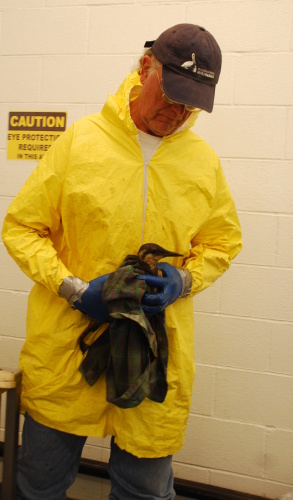
Volunteers and staff at the International Bird Rescue’s (IBR) Los Angeles center are putting in extra hours to wash, rehabilitate and care for an unprecedented number of oiled seabirds that are being delivered almost daily to the San Pedro facility.
The oil isn’t the result from a man-made rig or boat; this crude oil and tar is part of Mother Nature shedding some extra oil poundage. Natural oil seepage is common along SoCal coastlines; Coal Oil Point in the Santa Barbara Channel, for example, is the world’s largest natural seep, emitting thousands of gallons of oil every day.
No matter where the oil is coming from, seabirds and oil are never good mix. This year, the combination is particularly perplexing since the birds that are most affected by the gooey, smelly substance are common murres, a large auk that has, for the past few years, decided to make SoCal waters a favorite wintering destination.
Last year, these penguin-like birds were being found in the Santa Barbara/Ventura area with some spillover into Malibu. This year more of the oiled murres are coming from mainly Malibu and L.A. County beaches.
Since the beginning of the month, the IBR has seen 80 murres at their doorstep, one of the greatest influxes that anyone can remember.
It’s hard to say why there are so many Malibu murres this year. Are murres moving more south as a species? Are people just noticing them more? Are more just lucky to be washed ashore where willing hands can get them to a rescue center?
One thing is for certain, says Julie Skoglund, Wildlife Care Manager at IBR, “these birds would not survive without our help. They live mainly on the open ocean in the winter months – right where all the oil is seeping.”
Probably the biggest misconception about rescuing and tending to oiled birds is that the oil needs to come off immediately. They are not up for that exhausting procedure, says Skoglund. “The birds that come in here are emaciated and suffering from hypothermia. They are often just skin and bones. We have to stabilize them before they are ready for the cleaning process.”
And what a process it is.
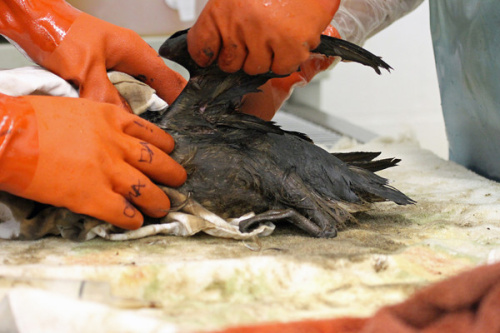
Once deemed strong enough, the smelly oily and blackened murre enters an assembly line-like room where strange but gentle hands take the bird through a three-step process that lasts about 40 minutes.First, the murre is pre-soaked with a methyl soyate, a biodegradable solvent that breaks down big tar chunks and sticky oily mats.
Next, birds are hustled over to be power-washed with Dawn dishwasher detergent (yes, soap DOES get in their eyes, but is quickly washed out).
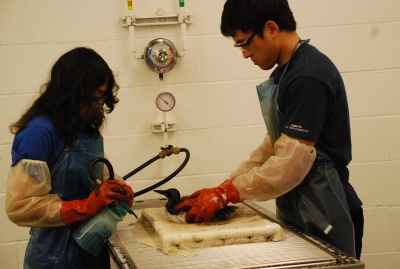
Afterwards, birds are rinsed followed by another washing stint. Every piece of tar must be removed. Every feathered must be inspected. Every residual of oil must be washed, brushed and sprayed away.
“Look at this,” says a volunteer showing a clean murre belly. “This used to be black as night.”
The impressively sparkling bird is finally brought to the drying pen where it huddles with others in a shared “What The Heck Just Happened?” experience. Soon enough, the murres are preening and fluffing feathers, a good sign their stress is subsiding.
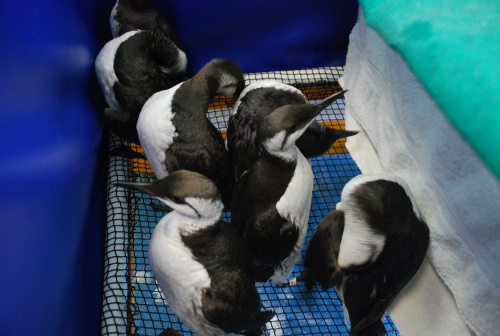
In between time in the drying pens, birds that have regained their waterproofing are given pool time to see how where they are in the recovery process. Some murres are buoyant, others, according to another volunteer, “sink to the bottom, so we know to give them more time.”
And finally, once their natural waterproofing is back up to speed, these cleaned murres are released into a large holding pool where they gregariously flap, swim and annoy each other – again, another good sign that they are on the mend. They will only be in here for a short time before they will be released back onto the coastlines.
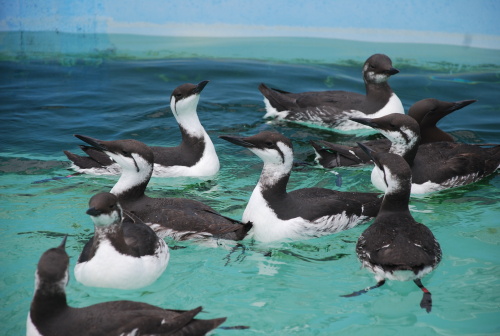
Two volunteers are taking murre temperatures and recording their vitals before putting them back into the drying pens. “We just want to get them home as quick as possible,” one says and she wraps the bird up in a towel. “I know it sounds crazy, but I don’t want to see them back here ever again.”
To be sure, the murres would probably concur.
Since these oiled birds are affected by natural seepage, and not from man-made reasons, the cost of rehabbing these critters comes out of IBR pockets. Overall, IBR will pay thousands of extra dollars in medicine, food and staff to care for these murres.
The IBR does receive some support from the California Department of Fish and Wildlife, but the non-profit asks the public to help with cash donations via www.birdrescue.org.
If you see a bird in distress that needs rescue call (866) WILD-911. To report oiled wildlife sightings, call (877) UCD-OWCN.
–By Brenda Rees, editor; feature photo by Bill Steinkamp
